The aim of this report is to shed light on the impact of the war on the global economy, both on developing countries and developed western countries. To do this, this report gives a brief history of the Russia-Ukraine war, identifies what the president of Russia, Putin, wants from this war, then discusses the importance of Russia to the global economy. Lastly, it highlights the different sanctions imposed on Russia by different countries and a somewhat optimistic conclusion.
To be sure, these are dark times.
Yet, tragedy can bring opportunities for positive changes.
Please, read on and share.
ab
Thursday, February 24, was a day that marked the start of a bleak new chapter in history as Russian troops crossed the Ukrainian border, announcing a full-scale invasion of their neighbor. This is the largest military operation in Europe since the end of the Second World War. As Jens Stoltenberg, the NATO Secretary-General, stated “Peace on our continent has been shattered… We now have war in Europe on a scale and of a type we thought belonged to history.” One month has passed since the start of the war and almost 7 million Ukrainian citizens are already internally displaced, while close to 4 million have fled to seek asylum in neighboring nations.
Following the Russian invasion of Ukraine, several countries imposed unforgiving sanctions on Russia and its ally, Belarus. Some of these countries include the U.S., EU, UK, Canada, and Japan. The war has also impacted the global economy, as prices of commodities, including food, energy, and metals have soared. We’ve explained in previous articles how the global economy is still recovering from the previous COVID-19 shock, with massive supply-chain and labor shortages, as well as persistently rising inflation. Inflation rates in the European Union (EU) and the U.S. hit record highs, reaching 6.2% and 7.9% in February, respectively. Russia and Ukraine are top players in the global markets for basic food, energy, and metal products. It is only natural that with the war in Ukraine and sanctions on Russia, global commodity prices would balloon further. Indeed, as shown in the graph below, the prices for commodities such as wheat and crude oil have substantially surged following the Russian invasion and passing of sanctions. Some experts project that U.S. inflation will hit 8.6% over the coming couple of months.
Figure 1 – Petroleum Crude Oil and Wheat Prices Since the Start of the Year
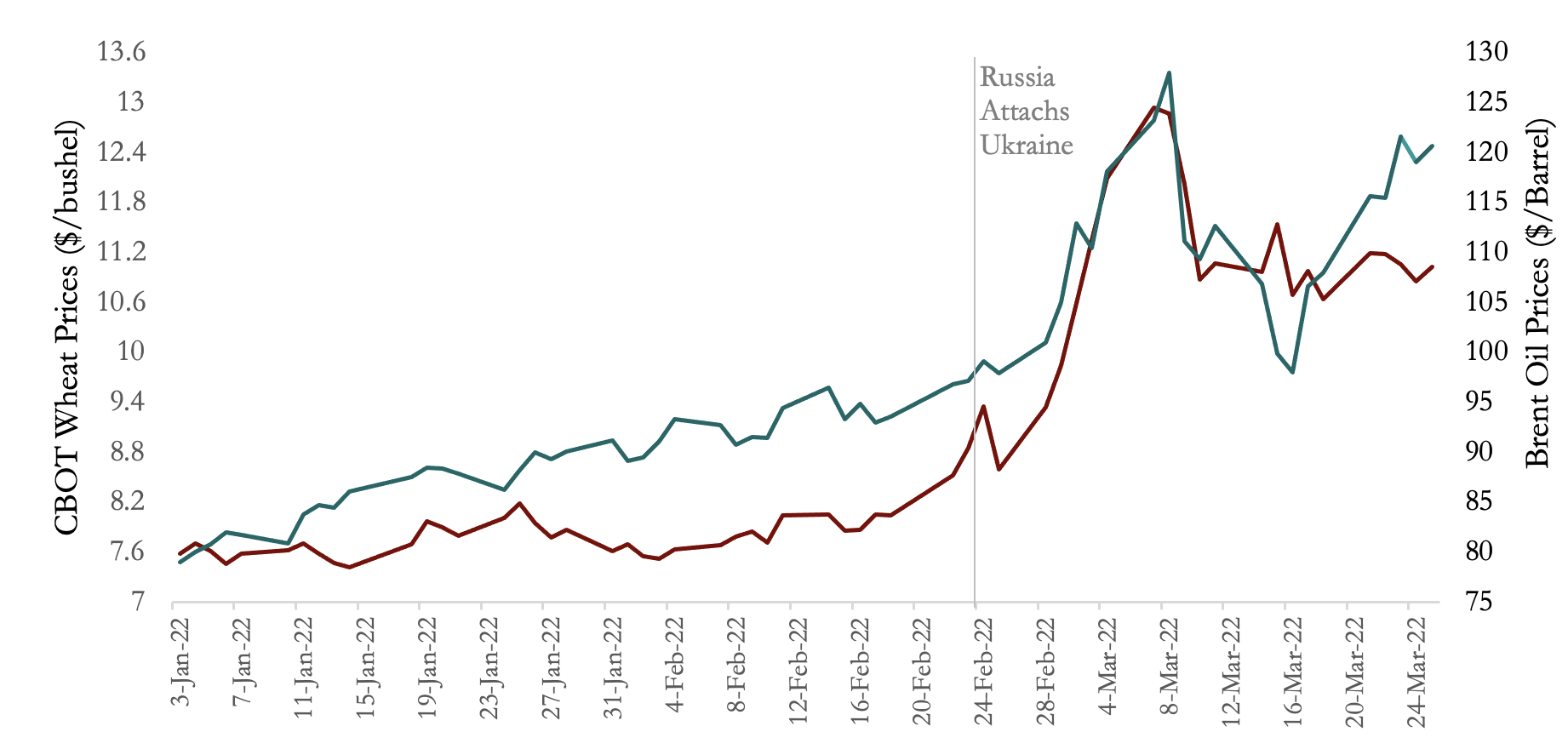
Source: Nasdaq Commodities. Author’s diagram.
Let’s go Back Eight Years Ago… When Russia First Invaded Ukraine
The tension between Russia and Ukraine is anything but recent. In the past, Ukraine was a major member of the Soviet Union. Since its independence in 1991, the relationship between the two countries has been strained. Ukraine was part of the Russian Empire hundreds of years ago and later became a critical part of the Soviet Union in the 20th century. The country has always maintained a special status in the bloc, given its large supply of crops such as wheat. Following the collapse of the Soviet Union in 1991, the country gained its independence. Since then, the Ukrainian government has been shifting into a democratic regime and growing its ties with the West. Yet, to a large extent, the country remained divided. While the Western territories of Ukraine grew closer to Europe, the Eastern parts, particularly the Russian-speaking, maintained strong cultural bonds with Russia.
This is not Russia’s first attempt to invade Ukraine since the collapse of the Soviet Union. To give more context to the current situation, we need to go back to 2014, when Russia annexed the Crimean Peninsula. Following the 2013-2014 Ukrainian Protests, when the Putin-supported president Viktor Yanukovych fled the country, Russia seized control of the Ukrainian Crimean territory. Supported by Russia, the Crimean parliament voted to split Crimea from Ukraine. On March 18, 2014, the Russian President announced the finalized annexation of Crimea. Since then, Russia has been in control of the Crimean territory. In response, the U.S and European allies imposed their first set of sanctions on Russia, while never officially recognizing the annexation.
Soon after the annexation, violence erupted in the eastern regions of Ukraine, where a majority of Russia-sympathizers still exist. In May 2014, Donetsk and Luhansk in the Donbas region (shown in the map below) declared their independence forming the Donetsk People’s Republic (DPR) and the Luhansk People’s Republic (LPR), calling themselves “Novorossiya”, which stands for “New Russia”. Hostility in the Donbas region has existed since then.
Figure 2 – Conflict in East Ukrainian Territories
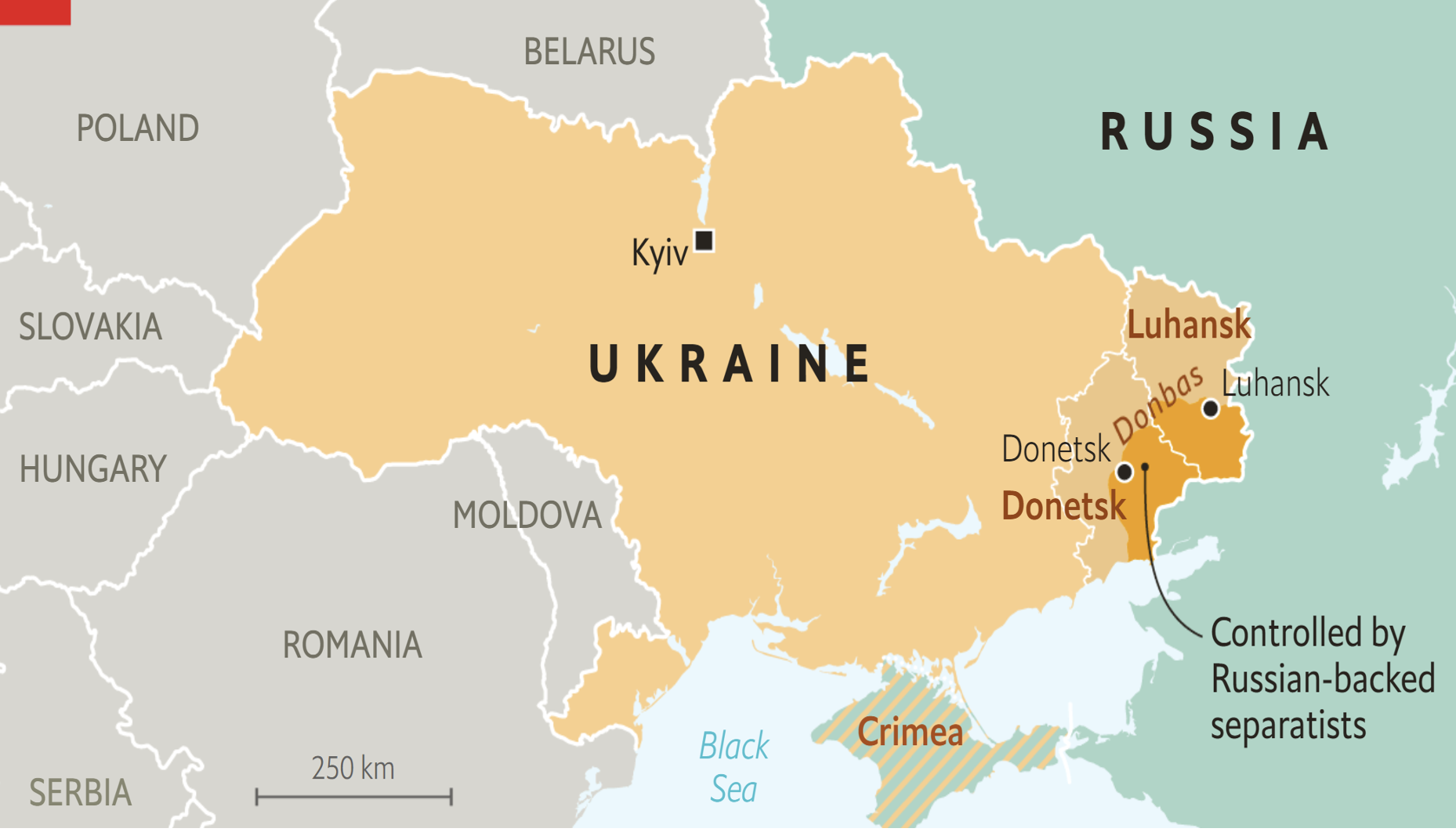
Source: The Economist.
What’s Putin’s Reasoning for The War? And What He Actually Wants?
Following the recent Russian invasion of Ukraine, Russian President Vladimir Putin argued that his efforts were only to “demilitarize and de-Nazifying” Ukraine, accusing the government of “genocide” against Russian-speaking citizens in the Donbas region. According to Putin, the modern, West-leaning Ukraine was a constant threat to the country, and Russia could not feel “safe, develop and exist.” The president accused “Banderites and neo-Nazis” of constructing heavy weapons and using human shields in Ukrainian cities. Andrei Kartapolov, the head of the Russian parliament’s defense committee, asserted that the Russian troops were sent to take control of the Ukrainian nuclear plants, to prevent President Zelensky “from building a dirty bomb” that he will use to attack Russia.
So, what does Russia really want?
While it’s a fool’s errand to attempt to read the mind of an autocrat like Putin, the conflict is likely motivated by Ukraine’s eagerness to build closer bonds with the West, especially the EU and the North Atlantic Treaty Organization (NATO). As far as Putin is concerned, Ukraine is still part of the “Russian Empire.” Putin has always denied Ukraine’s own history, arguing that Ukrainians and Russians have always been one. According to Putin “Ukraine never had a tradition of genuine statehood.” It is true that Russia and Ukraine share common cultural and family bonds. In the Eastern region of Ukraine, several Russian-speaking citizens still support Russian views. Yet, many Ukrainians do support cooperation and integration with the EU. And most, if not all, support free elections and representative government. Following the Second World War, NATO was constructed, mainly to protect Europe against a Soviet attack during the Cold War. Over the years, NATO expanded to include former-Soviet nations such as Estonia and Latvia. According to Putin, this is a betrayal of Russia by the West, who promised not to expand in the East. But according to NATO members, this promise has never been made.
The German Chancellor, Olaf Scholz, argues that what Putin really wants is to rebuild the Russian Empire. To him, the collapse of the Soviet Union marked the disintegration of historical Russia. According to Olga Lautman, a senior fellow at the Center for European Policy Analysis, “If he’s (Putin) able to reclaim some of this lost territory, on top of having a few satellite states, which he’s been attempting to do over the past decade… then at least he would have a legacy to leave in the history books of Vladimir the Great.”
It is important for Russia that Ukraine remains a “Neutral” country, with the least ties possible to the EU and NATO. In Russia’s view, NATO is an alliance with the primary goal of crippling and weakening the Federation. If Ukraine joins NATO, this will threaten Russia’s security as it will bring the alliance closer to Moscow. As stated by Putin, “If Russia faces such a threat as Ukraine’s admission to the North Atlantic Alliance, to NATO, then the threats to our country will increase many times, from which it is clear that all the countries of the alliance must fight on the side of one of their members if one Ally is considered as under attack.”
There is another important factor at work. Ukraine shares a large border with Russia and has free elections. It’s a dangerous country for an autocrat like Putin. It represents an example of a political structure controlled not by one man but by the citizens of the country. An autocrat views a free country as a threat to his power in his own country. In 2014, the Ukrainian Verkhovna Rada Committee voted to remove Putin’s puppet president Viktor Yanukovych from power and hold new elections after the Euromaidan protests demanding greater European integration. Russia, in turn, invaded Ukraine, annexed Crimea and began sowing violence via Russian supported “rebels” in Eastern Ukraine. Given the loopholes in the sanctions that followed this, Putin likely felt emboldened to keep acting in this manner. As Gary Kasparov presciently wrote in 2015, “Putin, like every dictator ever known before him, grows in confidence and support when he is unchallenged. Every step he can trumpet as a success to the Russian people makes it harder to remove him and more likely feel bold enough to take even more aggressive steps.” Sadly, Kasparov’s prediction has come true.
A Major World Food Basket, especially for Developing Countries
When it comes to global trade supplies, Russia and Ukraine are major players in food, energy, and metal markets. Ukraine and Russia play an important role in providing the world with major food commodities, as shown in the graphic below. Ukraine, in particular, is responsible for a substantial share of several dominant goods in global food markets. In 2020, both countries accounted for 72.5% of the global supply of sunflower oil, one of the world’s most used vegetable oils. Ukraine, alone, supplied 52.2% of world exports, with Russia contributing a share of 20.3%. India and China will particularly be affected. India imports 23% of its sunflower oil from Ukraine, while China imports almost 12% of its supply from Ukraine and Russia.
Figure 3 – Russia and Ukraine’s Shares of Global Food Exports, 2020
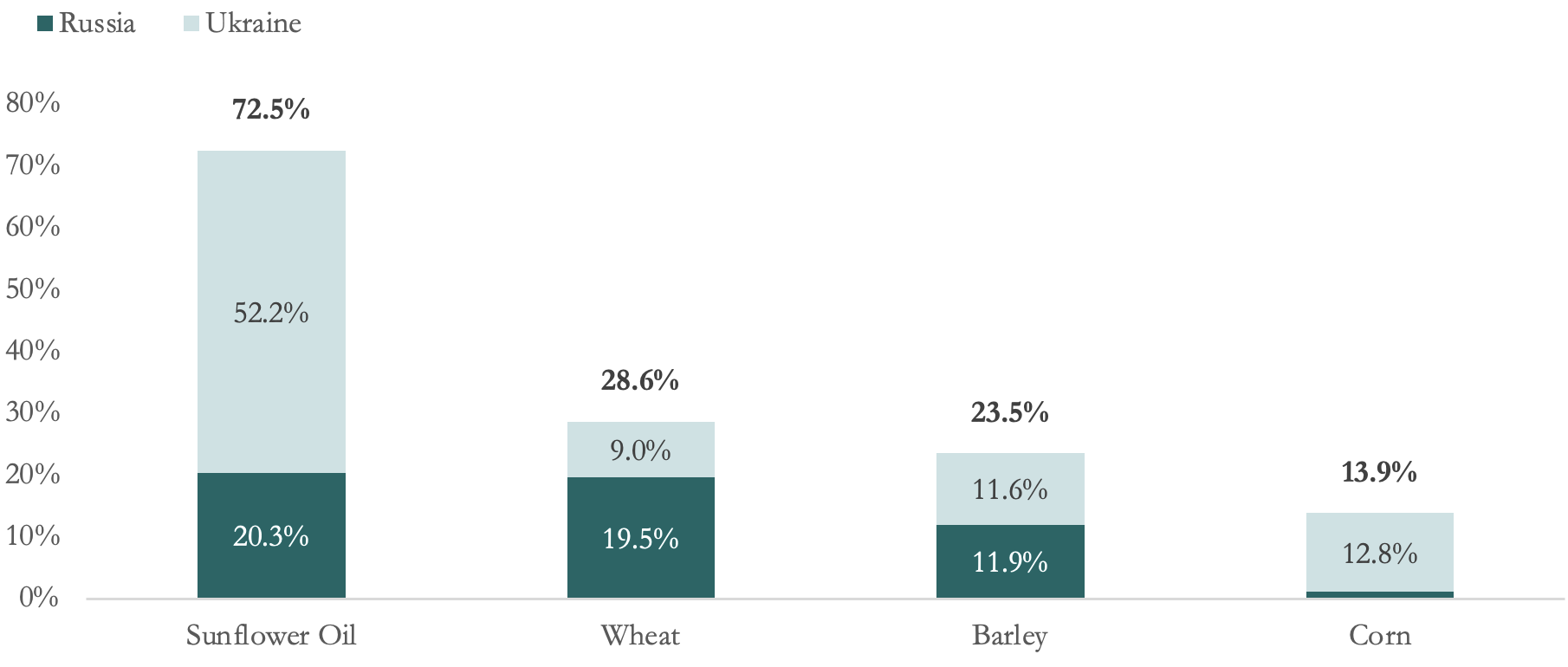
Source: MIT Observatory of Economic Complexity. Author’s diagram.
Russia and Ukraine are also significant suppliers of wheat to global markets. Wheat is a particularly critical commodity that affects global food prices as well as food security in several nations. As seen in the chart below, in 2020, Russia was the world’s largest exporter of wheat, accounting for a share of 19.5% of global exports. Ukraine came in fifth place after Russia, Canada, the U.S., and France, as it supplied 9% of the world’s wheat exports.
Figure 4 – Top-10 Wheat Exporters, Share of Global Exports, 2020
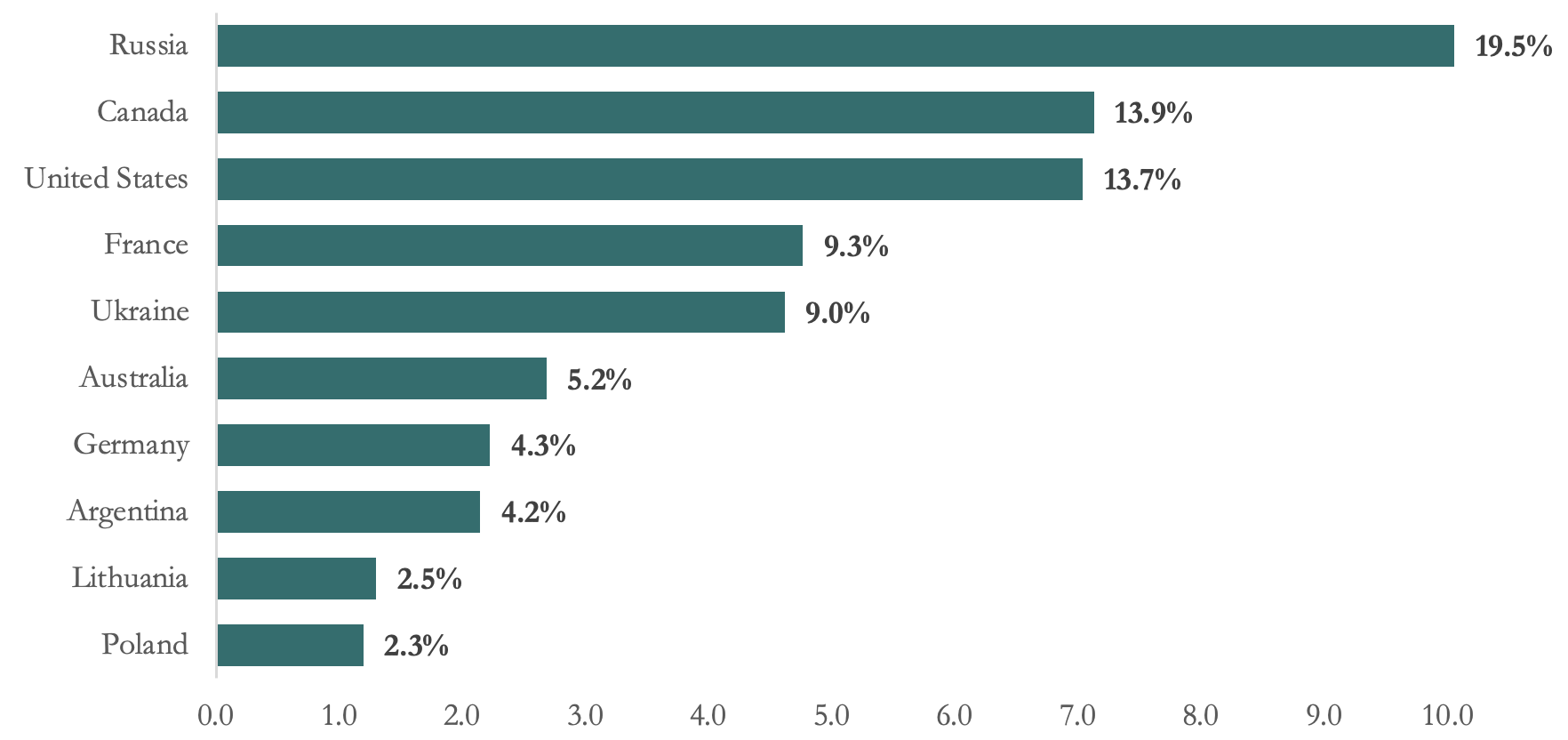
Source: MIT Observatory of Economic Complexity. Author’s diagram.
Several developing countries heavily rely on Russia and Ukraine for wheat. These two countries export almost 70% of their wheat to the 10 economies shown in the graph below. Egypt and Turkey are the two largest importers of wheat from Russia and Ukraine. In 2020, Egypt and Turkey imported 30.3% and 12.7%, respectively, of both countries’ exports. The supply of wheat from both neighboring countries is particularly critical for Egypt, which imported a total of $4.5 billion from them in 2020, accounting for 85.6% of its total wheat imports. In Turkey, supply from Russia and Ukraine also accounted for 76.5% of its total wheat imports.
Figure 5 – Top-10 Wheat Importers from Russia/Ukraine, Share of Russia/Ukraine Exports, 2020
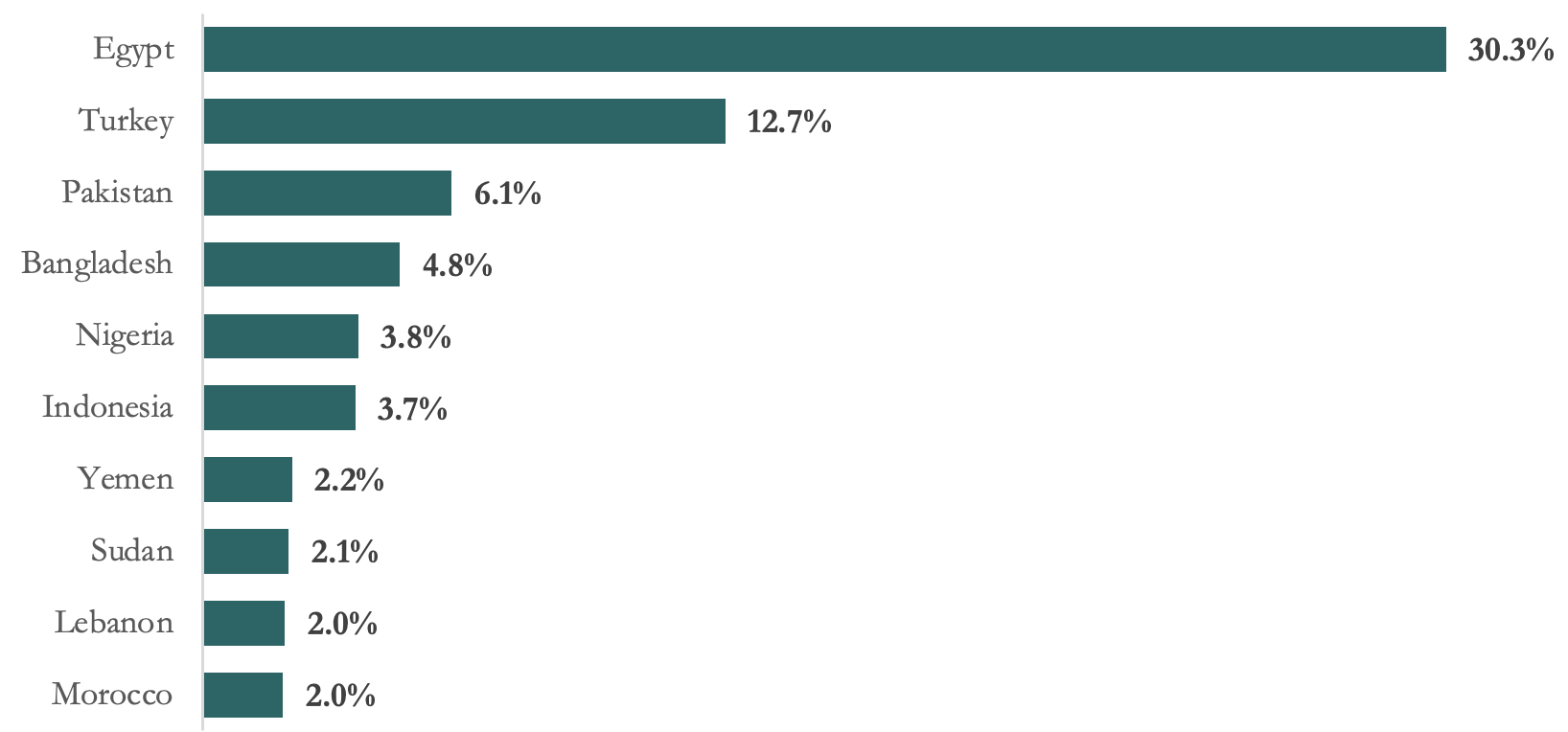
Source: MIT Observatory of Economic Complexity. Author’s diagram.
The problem doesn’t end here. Russia and Ukraine are also major global suppliers of barley and corn, which are two of the most dominant livestock feeds. In 2020, both countries exported almost one-quarter of the world’s barley supply and 14% of corn supply.
Russia is a Major Supplier of Energy
The global importance of Russia’s energy supply has been evident in the soaring prices following the war. Russia, followed by the United States, is the largest natural gas exporter in the World. The graph below shows Russia’s share in global exports of energy commodities. In 2020, Russia was responsible for one-quarter of global natural gas exports, 17% of which were in gaseous state and 7% as liquified natural gas (LNG). Russia is also a major player in the global market for coal. In 2020, the country exported 15.2% of the global supply of coal briquettes, making it the world’s third-largest exporter after Australia and Indonesia.
Figure 6 – Russia Shares of Global Energy Exports, 2020

Source: MIT Observatory of Economic Complexity. Author’s diagram.
When it comes to crude petroleum, Russia supplied 11.6% of global exports in 2020 making it the second-largest exporter of crude oil after Saudi Arabia. The U.S. and Canada come next, as they provided 8.2% and 7.4% of global petroleum exports in 2020.
The EU is especially reliant on Russian supply when it comes to Energy. The following chart shows the shares of different countries in the EU imports of crude oil and natural gas. In 2019, Russia’s share in EU energy imports was almost 41% for natural gas and 27% for crude oil. Moreover, the EU supplied 47% of its solid-fuel imports, mainly coal, from Russia.
Figure 7 – Share of Suppliers in EU Imports of Crude Oil and Natural Gas, 2019
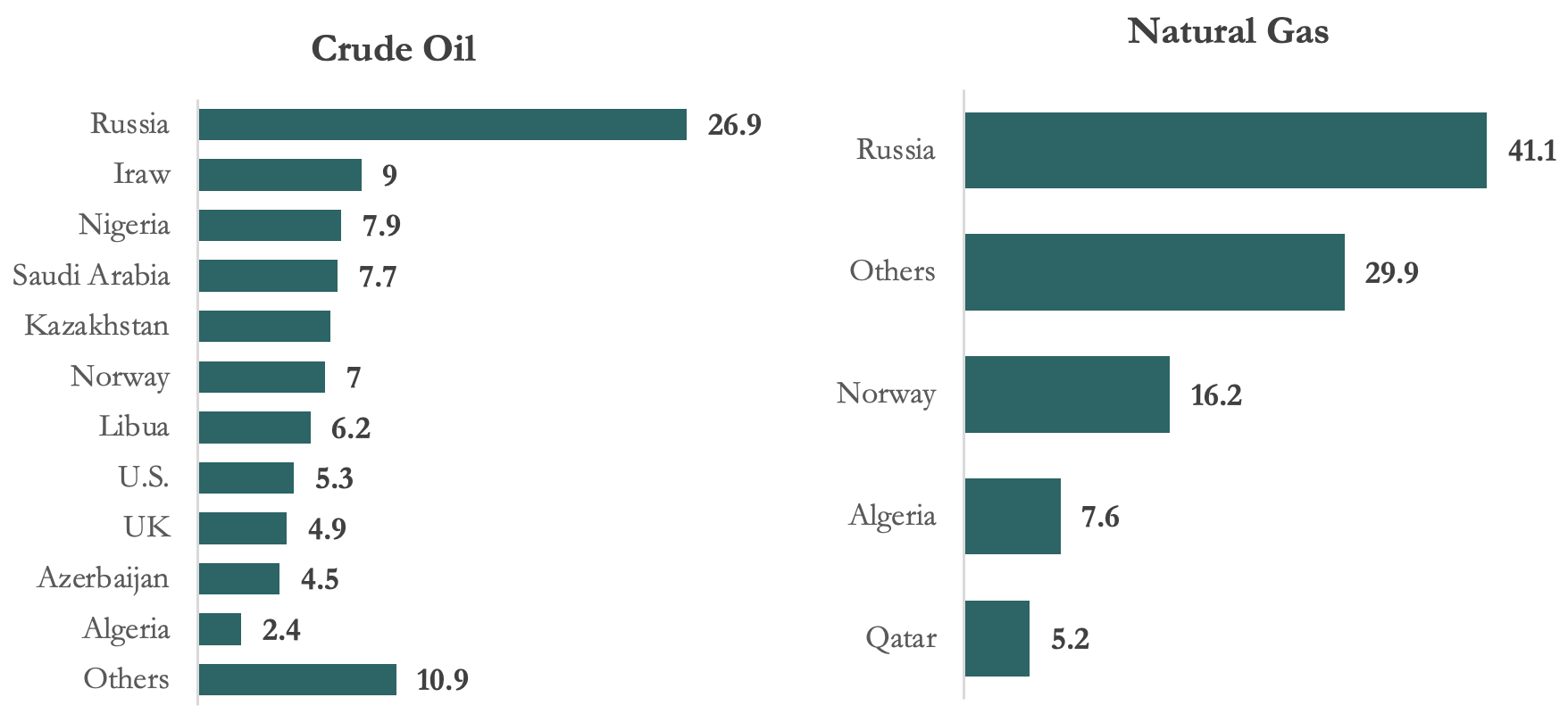
Source: Eurostat. Author’s diagram.
Within the EU, Germany and Italy are the two most vulnerable countries to Russia’s energy supply, as displayed in the next chart. In 2020, these two countries imported 42.6 and 29.2 billion cubic meters from Russia.
Figure 8 – Countries’ Shares of Russia’s Gas Exports, 2019, billions of cubic meters
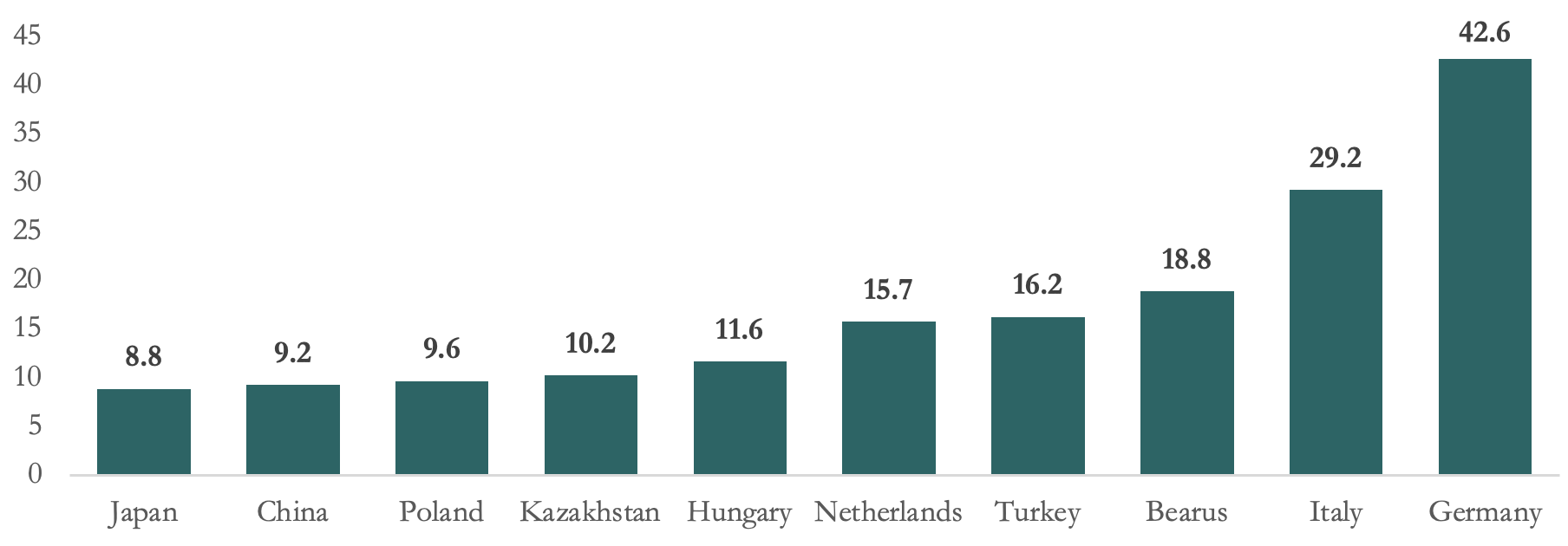
Source BBC News. Author’s diagram.
Russia is a Major Supplier of Metals and Industrial Products
Russia is also a major player in the market for several global metals, including nickel, uranium, palladium, platinum, aluminum, and iron. The graph below illustrates the share of Russian supply in the global exports of metals. In 2020, Russia produced over 20% of global exports in palladium, enriched uranium, and nickel. Ukraine is also a large exporter of natural uranium and its components, as it exported a global share of 19% in 2020. Russia also supplied 17% of the world’s platinum exports in 2020 and 9% of aluminum. Concerning Iron and Steel, Russia accounted for almost 5% of global exports, while Ukraine contributed close to 3%.
Metal supplies are important for a variety of industrial activities worldwide. For example, palladium is a rare metal that is used in the production of semiconductors, consumer electronics, as well as in the automotive industry. Nickel is also crucial in the production of nickel sulfates, which are used in battery manufacturing. Russia is one of the world’s largest producers of Class 1 nickel.
Figure 9 – Russia and Ukraine Shares of Global Metal Exports, 2020
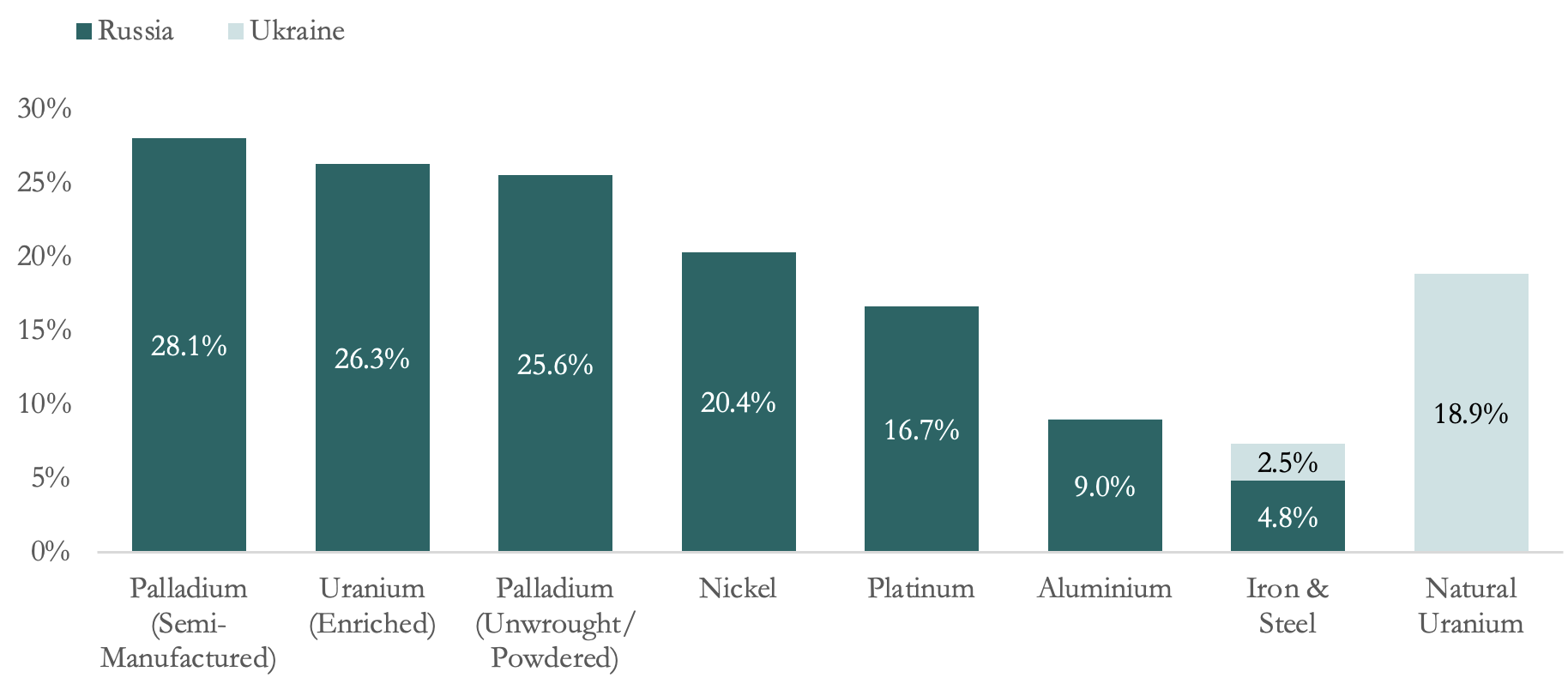
Source MIT Observatory of Economic Complexity. Author’s diagram.
Russia is also the largest exporter of fertilizers in the world. In 2020, 12% of total fertilizer exports were supplied by Russia. Mixed mineral and chemical, Nitrogenous, and Potassic fertilizers are Russia’s top products in this category. China, Canada, Morocco, and the U.S. follow Russia as top fertilizer exporters. In 2020, those four countries contributed shares of 11%, 9%, 6%, and 6% of global fertilizer exports, respectively (below chart).
Figure 10 – Top-10 Fertilizer Exporters, Share of Global Exports, 2020
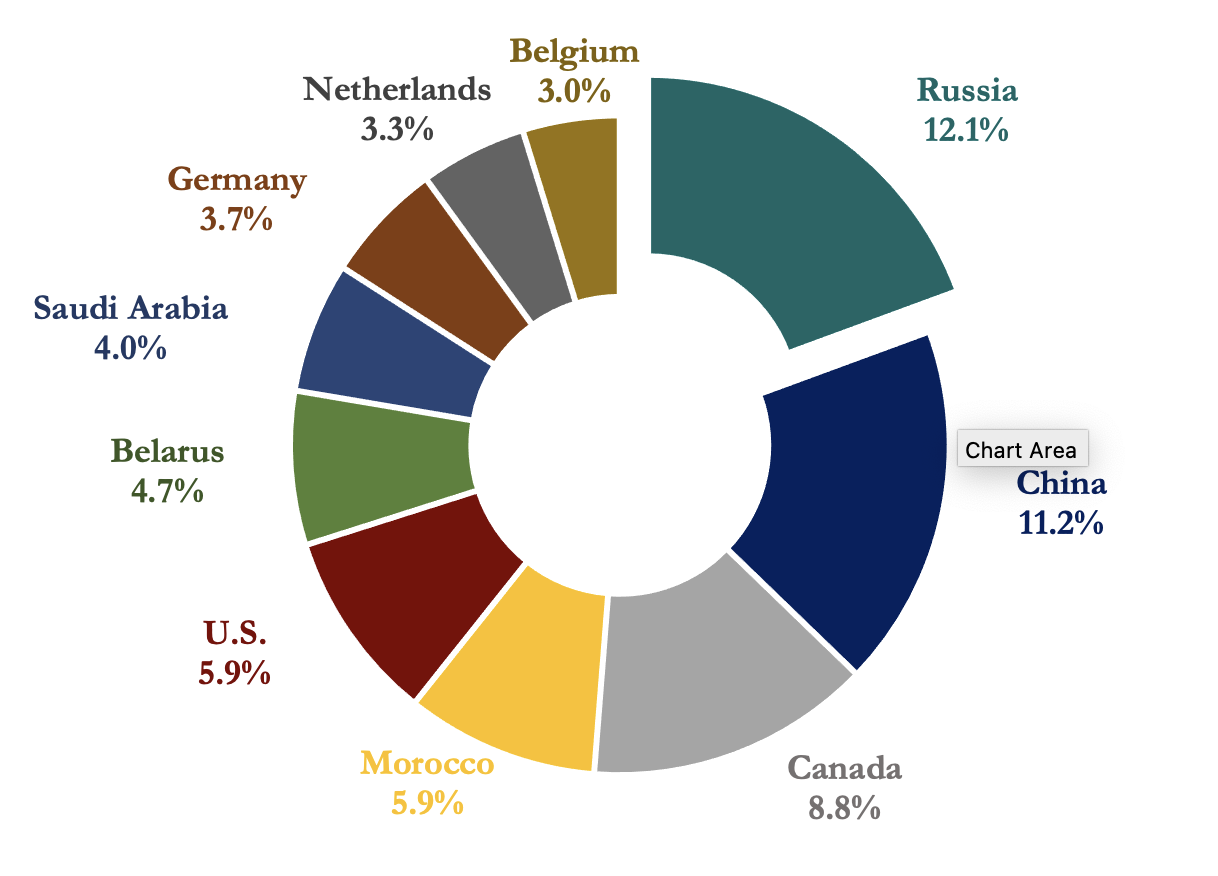
Source MIT Observatory of Economic Complexity. Author’s diagram.
Sanctions Imposed on Russia So Far
Following Russia’s attack on Ukraine, on the 24th of February, numerous sanctions have been ramped up against it from several countries, including the U.S., the U.K., the EU, and other nations. Between February 22 and March 26, a total of 3,559 sanctions have been globally imposed on Russia. A total of 812 sanctions have been set by the U.S., 779 by the U.K, and 673 by the EU.
Figure 11 – Number of Sanctions Imposed on Russia Since 2014
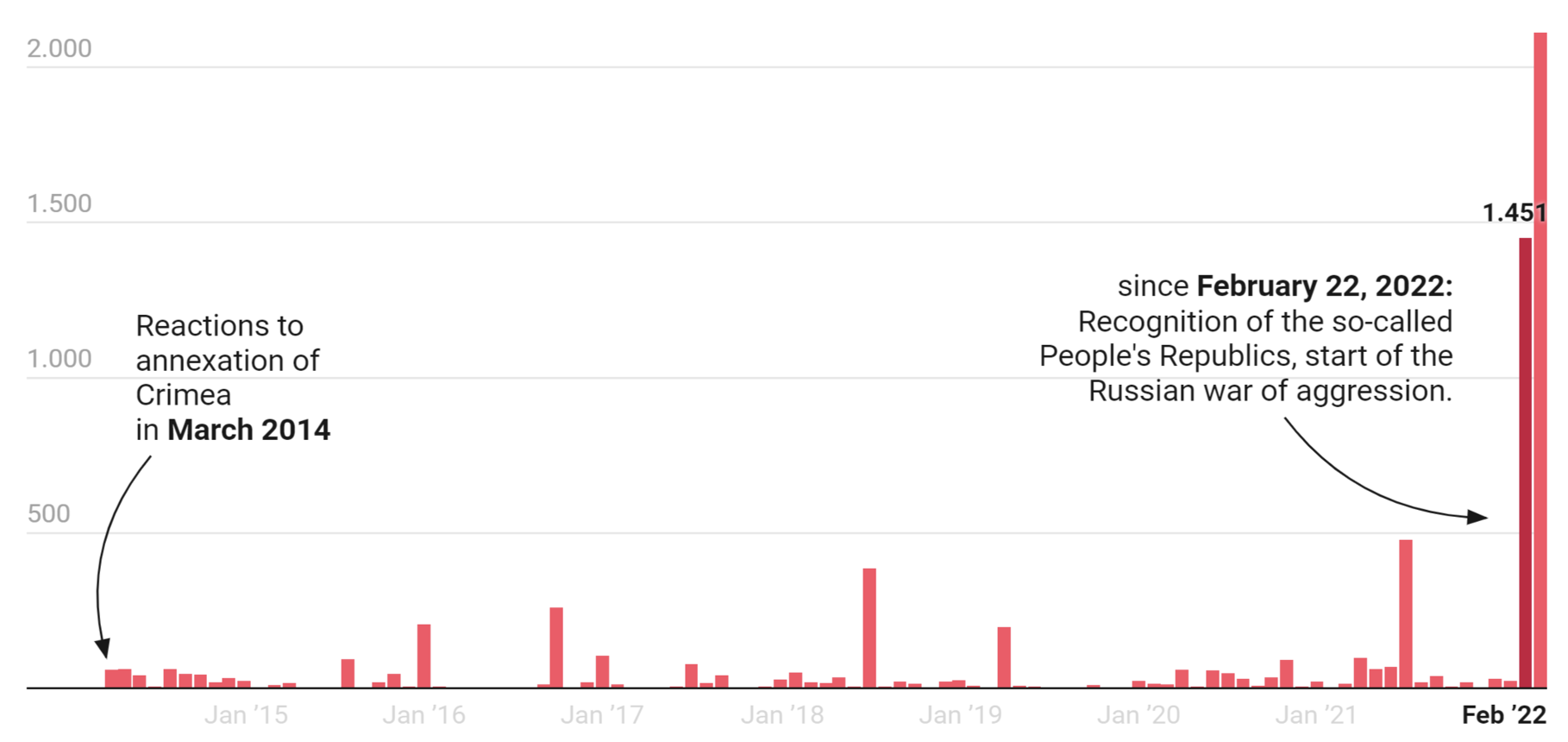
Source CORRECTIV Sanctions Tracker.
To date, the U.S., EU, UK, and Canada have imposed many restrictive sanctions on Russian officials and institutions. These include:
- Sanctioning Vladimir Putin, members of his family, other Russian officials and wealthy individuals. And preventing them from entering the country and freezing their assets.
- Banning Russian banks from using the SWIFT.
- Sanctioning the Russian Central Bank, Ministry of Finance, and Sovereign Wealth Fund. And freezing their assets.
- Banning exports from Russia, such as oil, gas, iron, and steel.
- Restricting local firms from exporting to Russian companies.
- Banning Russian flights and ships from entering the borders.
As the EU is more dependent on Russian natural gas than the U.S., for example, the region has still not fully banned imports of Russian gas. The EU’s foreign ministers have disagreed on whether there should be full sanctions on Russia’s energy sector. Germany is refusing such a stance given its high dependence on Russian energy. What has been agreed, so far, is to phase-out Russian energy in the EU earlier than previously planned, moving to other sources of supply.
For a detailed record of the sanction, we list the major ones imposed so far, by the U.S., EU, UK, and Canada.
Here is the detailed record of major sanctions imposed so far:
| Feb 22 | EU | Banning Politicians, Trade in Bonds, Imports and Exports
A set of rules that blacklist Russian politicians and officials, freezing their assets and forbidding them from traveling to the EU. Also bans EU investors from trading in Russian sovereign bonds and restricts specific Russian imports and exports with the bloc.
|
| Feb 24 | U.S. | Banning Exports of U.S. Tech to Russia
A set of U.S. exports to Russia have been restricted, requiring U.S. firms to obtain a license in order to sell navigation tools, telecommunications, computers, lasers, sensors, in addition to aerospace and marine equipment to Russian companies. In most instances, requests will probably be denied. This ban also requires overseas tech producers that use U.S. inputs to obtain a license before shipping to Russia.
|
| Feb 25 | U.S., EU | Sanctions against Putin and Lavrov
The U.S. and EU sanction the Russian president, Vladimir Putin, and the Foreign Affairs Minister., Sergey Lavrov, freezing their assets. The U.S. Treasury also imposes sanctions on the Russian Direct Investment Fund, a state-owned financial institution, freezing its assets.
|
| Feb 27
Feb 27 |
U.S., EU, CAN
U.S., EU, UK
|
Banning Russian Flights
Forbidding Russian flights from the U.S., E.U., and Canadian airspace.
Banning Russian Banks from Accessing SWIFT This restricts some Russian banks from using the SWIFT (Society for Worldwide Interbank Financial Telecommunication) international payment system. SWIFT is a channel that allows fast and easy money transfer across the globe, connecting around 11 thousand banks and institutions in 200 countries. If Russian banks cannot access the SWIFT payment system, it will become difficult for companies to transfer and receive payments, hindering lots of business and trade flows.
|
| Feb 28
Feb 28
Feb 28
|
CAN
U.S., EU, CAN
U.S., EU, UK
|
Banning Canadian Imports of Russian Oil
Canada announces that it will ban all imports of crude oil from Russia, the industry which most benefited Putin and other wealthy officials.
Sanctioning Russian Officials and Wealthy Individuals The EU, U.S., Canada, and Japan announce travel bans and asset freezes for a number of wealthy Russians, including businessmen in the oil and finance sectors, government officials, military officials, and other connected individuals.
Banning Major Russian Financial Institutions U.S., EU, UK, and Japan restrict businesses from commencing transactions with the Russian central bank, Ministry of Finance, and Sovereign Wealth Fund. Moreover, the UK freezes all assets of the state-owned Russian National Wealth Fund.
|
| Mar 01 | UK, CAN
|
Banning Russian Ships from Canadian and UK Ports
UK and Canada ban all Russian owned, operated, controlled, chartered, registered, or flagged ships from entering their ports.
|
| Mar 02
Mar 02 |
U.S., EU
EU |
Banning Russian Ships from U.S. and EU Ports
The U.S. and EU announce banning Russian-related ships from entering their ports, following the previous bans by the UK and EU.
Banning Russian Ships from U.S. and EU Ports The EU bans the state-controlled Russian media companies RT and Sputnik, following the distribution of deceptive information considering the Russian-Ukraine war.
|
| Mar 07 | CAN | Sanctioning Russian Individuals in Canada
Canada announces extra sanctions on 10 Russian individuals close to President Putin, including government officials and supporters of the Russian leadership.
|
| Mar 08
Mar 08
|
U.S.
UK |
Banning Russian Oil and Gas Imports in the U.S.
The U.S. decides to ban all oil and gas imports from Russia, completely forbidding the goods from entering U.S. ports.
Phasing-Out Russian Oil Imports in the U.K. The UK announces that it will phase out its crude oil and oil product imports from Russia, by the end of the year. The banning of natural gas imports is still being considered.
|
| Mar 09
Mar 09 |
EU
UK |
More EU Sanctions on Russian Individuals
The EU passes more sanctions on Russia and Belarus, its ally. Sanctions included several Russian officials and wealthy individuals, as well as the Central Bank and officials in Belarus.
More UK Aviation Sanctions on Russia The UK seizes a private plane connected to the Russian billionaire, Eugene Shvidler, a business associate of Roman Abramovich. Extra sanctions were imposed on aviation, allowing authorities to restrain any Russian plane and to ban aviation exports to Russia.
|
| Mar 10 | UK | Asset Freezes of Roman Abramovich
Extra UK sanctions imposed on seven Russian wealthy individuals, including Roman Abramovich, Chelsea’s Owner. This bans Abramovich from selling the Premier League Club and freezes his assets.
|
| Mar 11
Mar 11
Mar 11
Mar 11
|
CAN
U.S.
EU
U.S., EU |
Canada sanctions Russian billionaire Abramovich, others
Canada follows, sanctioning five Russian officials, including Abramovich, and barring 32 Russian companies and government entities from receiving defense equipment from Canada.
U.S. Sanctions on Putin’s Family Extra U.S. sanctions were imposed on several of Putin’s family members in addition to the Russian billionaire, Viktor Vekselberg.
Bans on Russian Imports and Exports The EU decides to ban exports of EU luxury goods to Russia as well as iron and steel imports from Russia. The EU also strives to ensure that the Russian wealthy cannot use crypto assets to evade sanctions.
An alliance to Apply Extra Economic Pressure on Russia The U.S. unites with some European allies to put extra economic pressure on Russia, restricting some of its imports (including iron and steel) and opening the door for high tariffs.
|
| Mar 14 | EU | EU Freezes Roman Abramovich’s Assets
The EU also announces the sanctioning of the Chelsea owner, Abramovich and freezes his assets.
|
| Mar 15 | EU | EU Sanctions Abramovich and Applies Some Sanctions on Energy
The EU intensifies its sanctions, imposing extra bans on the Russian oil and gas sector. While a full ban is imposed on Russian state-owned enterprises, EU members are still allowed to import oil and gas.
|
| Mar 24 | U.S.
|
More U.S. Sanctions on Defense Companies and Duma Legislative Body
U.S. imposes new sanctions on a dozen defense companies, 328 members of the Duma legislative body, and the CEO of Sberbank, the majority state-owned financial institution. The U.S. Treasury also stated that Gold-related Russian transactions may be sanctioned as well.
|
IN CONCLUSION
The Russian war in Ukraine has rocked the world, both politically and economically. The post-Cold War period of peace is officially over. Many countries have reacted with harsh sanctions to weaken Russian institutions and the benefiting oligarchs. Given the importance of both Russia and Ukraine in the global markets for food, energy, and metals, prices of major commodities have soared, and inflation has worsened. The outlook is still uncertain and the future for Ukraine is bleak. The negative possibilities of this war are limitless. A global food crisis? A global economic meltdown of devastating proportions? Continued Russian aggression in Poland or Baltic states?
But one thing is clear, the sooner this devastating war comes to an end, the better for everyone. Given how several countries in the EU and other regions have already set plans to phase out Russian commodities over time, and the destruction that this war might leave for Ukraine, higher prices will continue for some time.
However, there is cause for optimism. Who would’ve conceived a scenario where both Sweden and Switzerland stopped their neutrality and joined the West to sanction Russia? Or Germany meeting their 2% NATO target by adding $100B to their defense spending budget? Or a former comedian turned Ukrainian president demonstrating strength and tenacity to rally his people and stall the Russian invasion?
If COVID taught us anything, it’s that the West can adapt and overcome tragedy. We will see dramatic changes in supply chains, in the development of domestic sourcing of commodities and an overall reduction in globalization. We will not see an elimination of the need for, or even much a reduction in, fossil fuels. But the world will make three important changes. First, it will seriously review all autocratic sources of energy. Second, high energy costs will bring about significant efficiency changes to how energy is utilized (Ex: heat pumps vs. gas for homes). Third, it will make more thoughtful choices on the transition towards renewables.
To be sure, these are dark times.
Yet, tragedy can bring opportunities for positive changes.



Andy
I so appreciate your views of world economic events and issues. Your comments are well written and so timely. Keep up the good work!
Mike
Thanks Mike. The acceleration of change continues in our lives. Glad you found the research helpful!